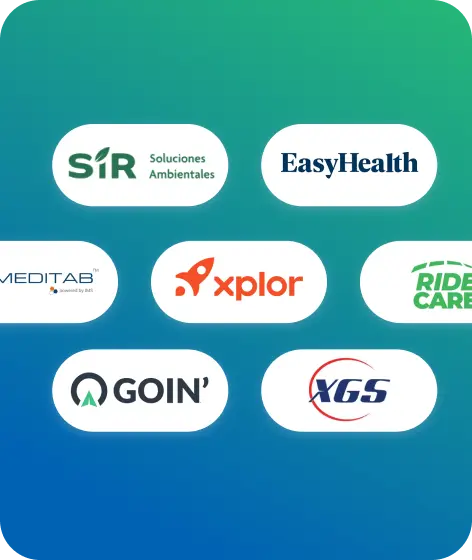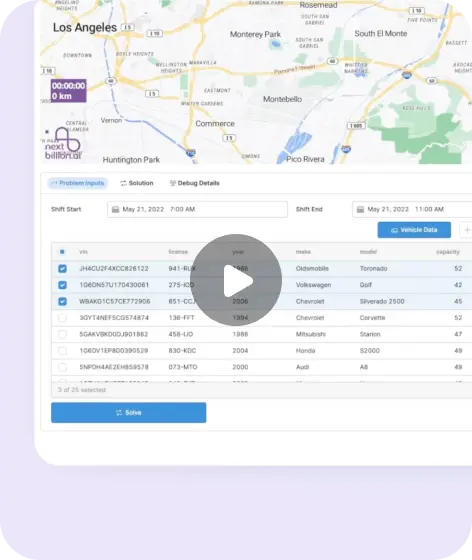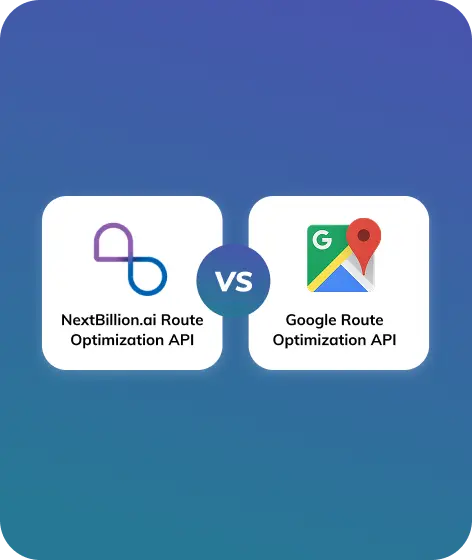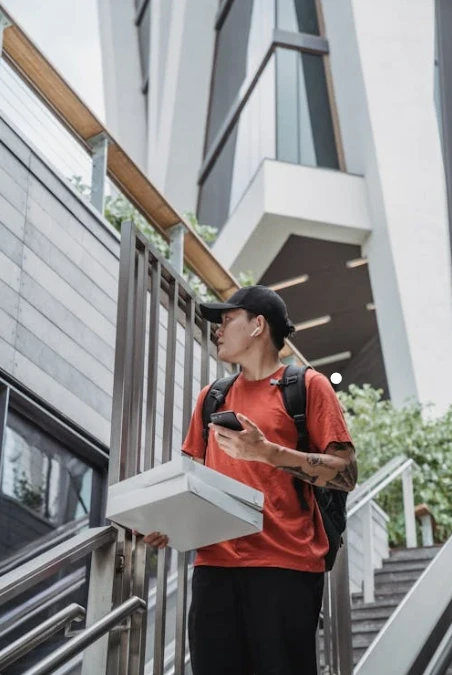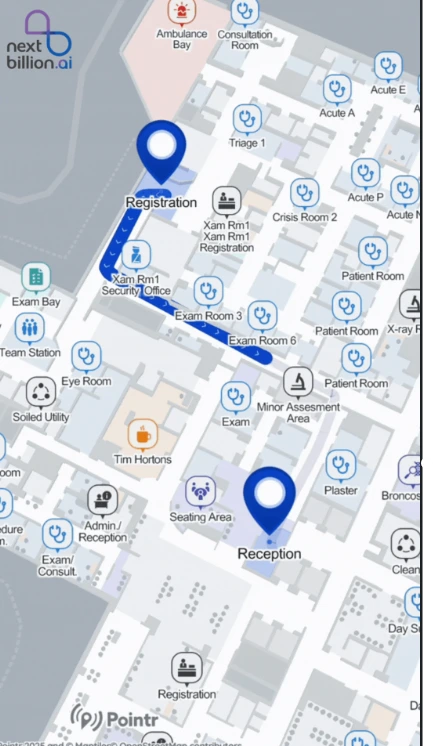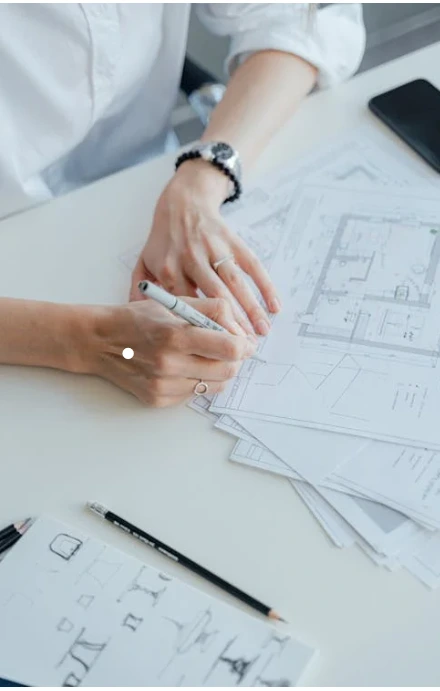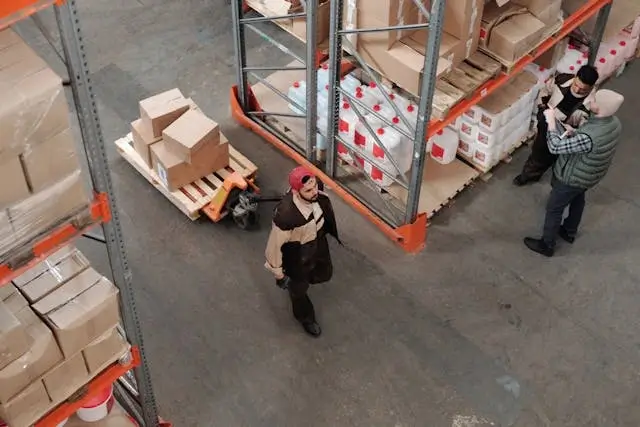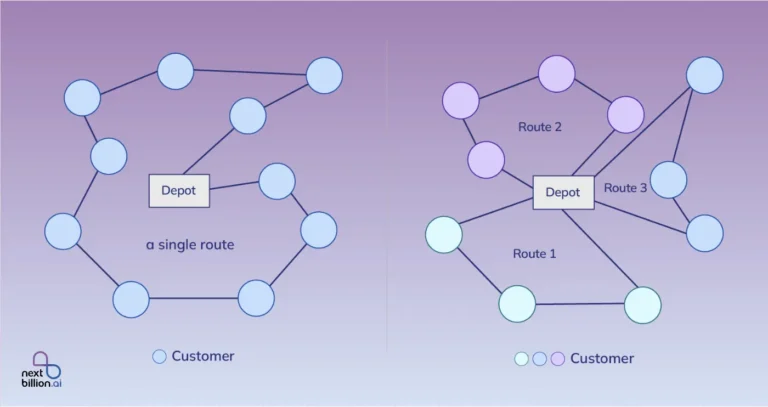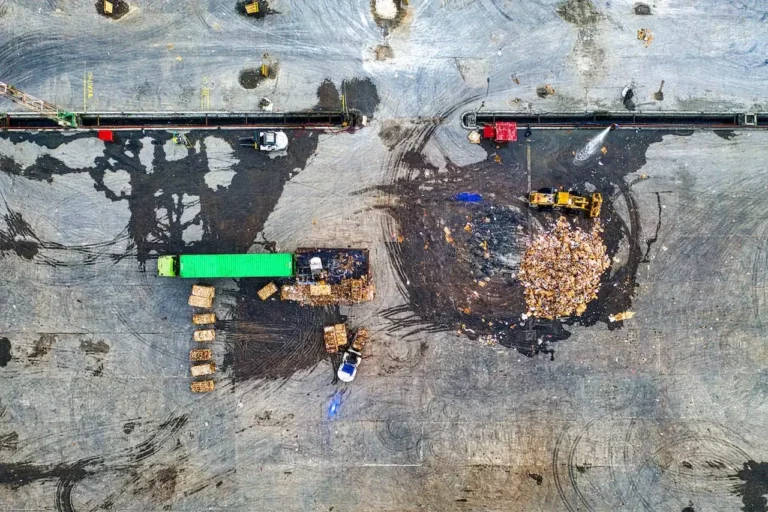Table of Contents

- BLOG
What is Indoor Route Optimization? A Guide for Warehouses, Factories, and Retail Venues
Have you ever lost precious minutes searching for an item in a vast warehouse, navigating endless aisles in a retail store, or waiting for materials to arrive in a busy factory? These delays may seem small, but across large facilities they quickly add up—impacting efficiency, costs, and customer satisfaction. This is where indoor route optimization comes in.
It helps people, goods, and even autonomous robots move through complex environments more efficiently. By combining digital indoor maps, smart sensors, and intelligent algorithms, it ensures faster navigation, reduces wasted effort, and improves both operations and user experience.
For industries like warehousing, manufacturing, and retail, where time and accuracy are critical, indoor route optimization is no longer just a convenience it’s becoming a necessity.
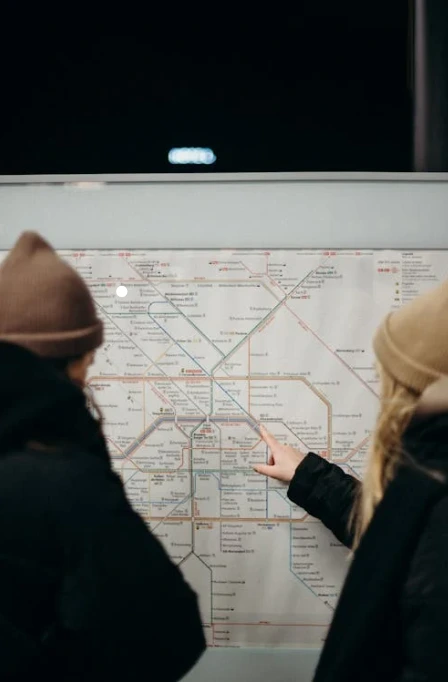
What is Indoor Route Optimization?
The technique of designing and overseeing the most effective routes within sizable interior areas, such as factories, warehouses, airports, hospitals, and retail establishments, is known as indoor route optimization. It facilitates the efficient movement of people, products, and machinery through intricate layouts by cutting down on needless travel, increasing production, and saving time.
Indoor optimization employs a combination of digital indoor maps, sensors, Wi-Fi, Bluetooth beacons, RFID tags, and AI-powered algorithms to determine the optimal routes, in contrast to outside navigation, which depends on GPS and road networks.
Why Indoor Route Optimization Matters for Warehouses, Factories, and Retail Venues
Warehouses, industries, and retail establishments are examples of indoor areas that are constantly moving. Employees, equipment, and goods must all work together harmoniously, but without an efficient structure, things frequently become chaotic, expensive, and time-consuming. These issues are addressed by indoor route optimization, which maximizes efficiency, minimizes errors, and streamlines movement.
Efficiency, Time Savings, and Cost Reduction
By minimizing needless transit within facilities, indoor route optimization greatly increases operational efficiency. Productivity rises as a result of workers, robots, and materials spending less time commuting between places.
Optimized picking routes in warehouses can reduce travel time by as much as 50%, enabling employees to finish more orders in a single shift. On-time delivery of tools and raw materials in factories minimizes downtime and maintains production lines. Retail staff can help customers or replenish inventory more quickly, which enhances customer service and shop efficiency.
The optimization of indoor routes reduces operational expenses by reducing unnecessary effort and simplifying movement. Forklifts, automated guided vehicles, and employees moving between shelves all use less energy and labor when their trip distances are shorter. Additional savings result from fewer mistakes, missed delivery, or misplaced things.
In the end, interior route optimization makes the operational flow in factories, retail stores, and warehouses smarter, quicker, and more economical. Better customer experiences, more efficient production, faster order fulfillment, and increased worker productivity are the outcomes—all while keeping costs under control.
How Indoor Route Optimization Works
Indoor route optimization relies on digital maps, real-time tracking technologies, and intelligent algorithms to guide movement efficiently through complex indoor spaces. Unlike outdoor navigation, GPS is ineffective indoors, so facilities use alternatives such as Wi-Fi or Bluetooth beacons, RFID tags, LiDAR, or sensors to track employees, inventory, and autonomous robots.
The process begins with mapping the space: creating a detailed digital layout of aisles, shelves, equipment, entrances, exits, and restricted areas. Once the map is ready, tracking technologies collect real-time location data of people, goods, and devices.
Next, smart algorithms analyze the map and movement data to determine the optimal routes. These algorithms consider distance, expected travel time, congestion, accessibility (e.g., elevators vs. stairs), and safety rules (no-go zones, restricted areas).
Finally, the optimized routes are communicated to users through mobile apps, kiosks, handheld devices, or robot navigation systems, ensuring employees, customers, and autonomous machines follow the most efficient path. Continuous learning from movement patterns allows the system to adapt and improve over time, maximizing efficiency and reducing operational costs.
Indoor Route Optimization by Industry
Industry | Key Benefits | Examples of Impact |
Warehouses | Faster picking, reduced travel time, fewer errors, increased productivity | Optimized routes reduce pickers’ travel time by up to 50%, leading to faster order fulfillment and lower operational costs. |
Factories | Efficient material flow, decreased downtime, safer operations, cost control | Well-planned routes ensure raw materials and tools reach production lines on time, minimizing stoppages and accidents. |
Retail Locations | Improved staff productivity, better customer experience, reduced congestion, operational insights | Employees can quickly restock or assist customers; shoppers are guided efficiently to desired products, enhancing satisfaction and sales. |
The goal of indoor route optimization is to create a more intelligent, secure, and economical operational flow, not only to save time. It means quicker deliveries for warehouses. It means more efficient manufacturing for factories. It means a better shopping experience for retail establishments. When combined, these advantages offer companies a significant competitive advantage.
Benefits of Indoor Route Optimization
Indoor route optimization offers quantifiable corporate benefit in addition to convenience. By simplifying travel inside complicated settings, organizations can uncover various benefits:
1. Efficiency & Time Savings
Workers at factories and warehouses spend a significant amount of their day just going from one location to another. Employees can accomplish more work in less time by using optimized routes to save commute time, which immediately increases productivity.
2. Lower Operating Expenses
Within a facility, labor and operating costs increase with each additional step or postponed delivery. Long-term cost reductions can be achieved by minimizing downtime, reducing wasted work, and even lowering energy consumption for autonomous vehicles through indoor route optimization.
3. Better Experience for Customers
Customers demand easy and hassle-free purchasing in retail. Indoor navigation can enhance the likelihood that consumers will make a purchase, decrease annoyance, and direct them directly to the things they desire. A better in-store experience also promotes loyalty and encourages repeat visits.
4. Better Management of the Workforce
Order picking, material handling, and restocking are examples of tasks that become more organized and predictable with optimized routes. In addition to lessening worker tiredness, this enables management to more efficiently distribute resources.
5. Improved Accessibility and Safety
Businesses lower the chance of accidents by directing employees or guests along accessible, safe routes. Indoor route optimization can potentially offer the quickest escape options in an emergency.
6. Practical Data-Based Insights
Indoor navigation systems provide useful information on space usage, workflow bottlenecks, and foot traffic. These information can be used by businesses to enhance design, optimize processes, and better prepare for periods of high demand.
Efficiency and customer happiness are the two things that organizations worry about the most, and indoor route optimization has a direct impact on both.
Challenges and Considerations
Whether it’s hospitals expediting patient and staff movement, airports directing travelers, retail malls enhancing client navigation, or warehouses handling massive inventories, indoor route optimization has become a crucial necessity across industries.
Building and maintaining a successful indoor routing system isn’t easy, though. Businesses need to take into consideration the special challenges that indoor surroundings present. The main obstacles and factors that affect indoor route optimization projects’ success are broken down below.
1. Absence of Standardized Indoor Maps
Indoor locations lack uniform mapping standards, in contrast to outdoor navigation, where trustworthy data is provided by mapping systems such as OpenStreetMap or Google Maps. Every building has a different layout, whether it’s a factory, hospital, or shopping center.
Custom scanning, manual updating, or interaction with CAD/architectural drawings are frequently needed for creating digital indoor maps. Deployment is slowed down and operating costs are increased by this lack of standardization.
2. Signal Restrictions and Accurate Positioning
Signal blockage makes GPS, the foundation of outside navigation, essentially useless indoors. Rather, alternatives such as RFID, LiDAR, Bluetooth beacons, Wi-Fi triangulation, or Ultra-Wideband (UWB) are employed. There are trade-offs for each:
- Wi-Fi and Bluetooth → Lower cost but less accuracy.
- UWB and LiDAR → High accuracy but require significant infrastructure investment.
A few meters of inaccuracy outdoors may not matter, but indoors, it could mean sending a worker to the wrong shelf or a patient to the wrong ward.
3. Continually Modifying Layouts
Indoor environments are dynamic. Aisles are frequently rearranged in warehouses, hospital corridors are blocked during emergencies, and retail establishments modify their product displays. Indoor areas require adaptable systems that adjust to changes in real time and frequent map updates, unlike roadways, which are generally constant.
4. Complex Obstacles and Multi-floor Navigation
Stairs, elevators, escalators, security-restricted areas, tight aisles, and even moving obstructions like forklifts or cleaning robots are all issues that indoor routing must deal with. Because multi-floor navigation is so complicated, algorithms must take vertical movement into account while maintaining accessibility(e.g., wheelchair-compatible routes).
5. High Scalability Demands
Airports, factories, and shopping malls are examples of large venues that may have to handle thousands of people or devices at once. Inadequate scalability can result in latency, subpar performance, and irate users.
6. Energy and Device Constraints
Batteries are frequently utilized in handheld scanners, mobile gadgets, and interior autonomous robots. Optimization systems must strike a compromise between performance and energy economy because real-time location and frequent rerouting use a lot of energy.
Future of Indoor Route Optimization
The field of indoor route optimization is still developing, and more intelligent, automated, and user-friendly technologies are anticipated in the future. Businesses may anticipate advancements that will make interior navigation more sophisticated and smooth as technology develops.
1. AI-Powered Intelligent Structures
Predicting and controlling mobility within buildings will be largely dependent on artificial intelligence. AI-powered systems will do more than simply respond to current circumstances; they will:
- Be prepared for congestion before it occurs.
- Make route recommendations based on anticipated demand.
- Customize the navigation for staff, customers, or patients.
AI, for instance, can optimize productivity in a warehouse by automatically modifying picker routes in response to incoming orders.
2. Combining Autonomous Vehicles and Robotics
Robots and AGVs (Automated Guided Vehicles) are being used more and more in factories and warehouses. Their “navigation brain” will be indoor route optimization, which will guarantee that these machines travel securely beside people without running into obstacles or delays. This will result in highly automated workplaces where machines and humans work together.
3. Wayfinding in Augmented Reality (AR)
In the future, screen maps won’t be the only way to navigate. Employees and clients might see highlighted routes or visual arrows superimposed on the actual surroundings using AR-enabled glasses or smartphones, which would make navigation simple and error-free.
Consider a patient who uses the digital arrows on their phone screen to go to a department without requesting instructions.
4. Green operations and sustainability
Route optimization will help achieve sustainability goals in the future in addition to saving time. Businesses can reduce energy consumption, equipment wear and tear, and carbon emissions—even within buildings—by minimizing needless motions.
Increasing the intelligence, automation, and people-centeredness of facilities is the key to the future of indoor route optimization. Early adoption of these innovations will give businesses a competitive edge in operational excellence and customer happiness in addition to increased efficiency.
Introducing NextBillion.ai’s Indoor Route Optimization Platform: Smarter Navigation for Complex Spaces
Our philosophy at NextBillion.ai has always been that routing shouldn’t end at the door. Despite the tremendous advancements in outdoor navigation over the years, companies continue to face a significant obstacle like how to maximize mobility in expansive, intricate inside environments. Consider this:
- Every day, a warehouse picker travels miles in order to complete orders.
- A member of the medical staff pushing equipment through packed hallways.
- A grocery employee moving through aisles to fulfill orders for online pickup.
What if, like outside routing, all of this movement could be mapped, optimized, and visualized? Our recently developed Indoor Route Optimization Platform enables just that.
From Floor Plans to Routable Maps
City streets don’t look like inside places. They have elevators, racks, aisles, and access controls. Our technology allows you to create completely routable indoor maps from your current layouts, whether they be internal schemas or CAD files.
This makes your store, factory, hospital, or warehouse a digitally navigable space that is prepared for optimization.
One Seamless Indoor-Outdoor Journey
Operations don’t often fall neatly into “indoor” and “outdoor” categories in the actual world. Deliveries frequently start outside and finish within a structure. We created our technology to easily integrate indoor and outdoor routing because of this.
Without juggling multiple tools or systems, you can now arrange a complete trip from a delivery truck outside your warehouse to the precise shelf where the product has to go.
See Your Routes in Action
Optimization is about clarity, not just algorithms. With our technology, you may view optimum routes directly on venue-specific bespoke maps.
- Managers can track workflows in real time.
- Staff can follow clear, optimized paths.
Businesses can make faster, data-driven decisions.
The Future of Routing is Indoors
People frequently picture automobiles, trucks, or delivery bikes negotiating city streets when they think about routing. Technology has revolutionized outdoor navigation; GPS, real-time traffic updates, and AI-driven optimization have made city-to-city travel quicker and more intelligent than ever.
Most of the world’s work doesn’t stop at the doorstep:
- The box must still navigate aisles, shelves, and loading bays once the delivery truck pulls up to the facility.
- Essential supplies are delivered to the hospital, but they have to make their way through wards, hallways, and elevators to get to the appropriate department.
- Even with online grocery ordering, store employees still have to maneuver through aisles to quickly select things.
The next significant advancement in routing will take place within our buildings rather than on the highways.
Powering the Next Era of Routing with NextBillion.ai
The definition of routing is growing as industries change. Nowadays, it’s more important to make sure that people, assets, and things move smoothly inside the areas where actual business takes place than it is to get trucks over highways or cars through city streets.
That’s precisely what NextBillion.ai is for. We’re assisting companies in converting static indoor layouts into dynamic, intelligent, and effective routing ecosystems with our Indoor Route Optimization Platform. We’re helping businesses in factories, supermarkets, hospitals, and warehouses to:
- Make an accurate map of indoor areas.
- Real-time multi-agent workflow optimization
- Close the distance between movement in the indoors and outside
- Make better judgments by visualizing procedures.
We at NextBillion.ai think that indoor routing is the way of the future, and we’re developing the technologies to make that a reality right now. Because businesses not only move more quickly but also more intelligently when every aisle, corridor, and floor is optimized.
About Author
Divya Nair
Divya is a dedicated Technical Content Writer with experience of two years in the industry. Her expertise spans various forms of writing, including blogs and website content.
Ready to get started?
Table of Contents
Related Posts
Ready to get started?
Request a DemoTable of Contents
Subscribe to our Newsletters
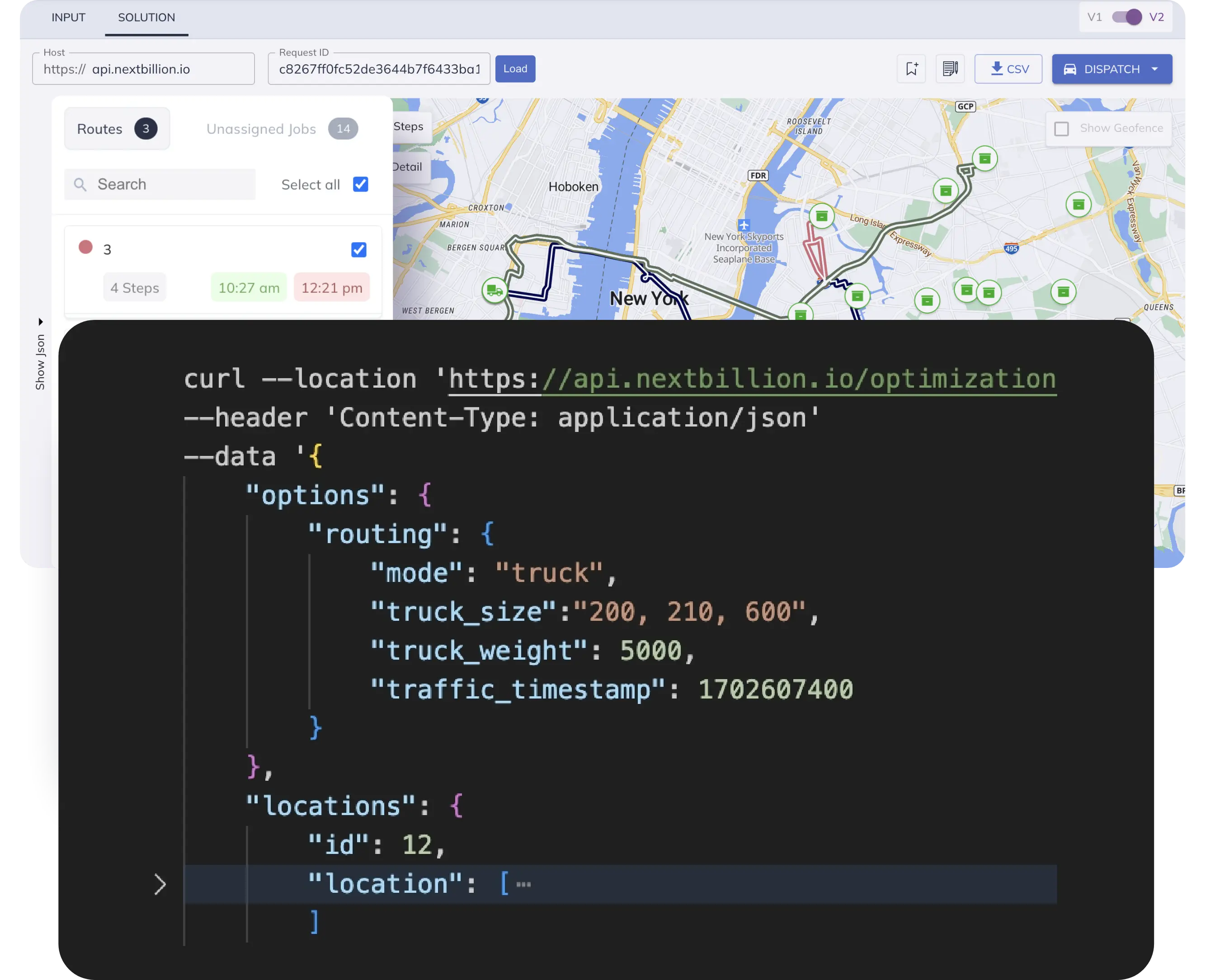
Get the best practices for route planning & optimization, delivered to your inbox.
Subscribe
